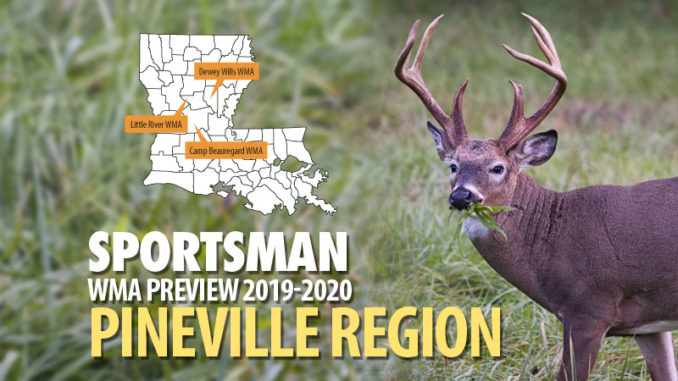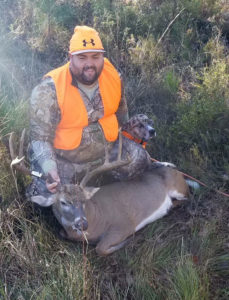
Deer
Biologist Cliff Dailey of LWDF is holding his breath in the months before deer season opens on the Dewey W. Wills WMA.
On the one hand, you have the proven, 63,901-acre WMA in LaSalle, Rapides and Catahoula parishes that is frequented by more hunters each season and sets the pace for deer harvested in the region. It has everything: bottomland hardwoods, slough and cypress brakes and plenty of nutall, willow and overcup oak among old, dying trees that, combined with timber harvests, have created canopy gaps responsible for briar thickets so beneficial for deer. No wonder hunters harvested 454 deer last season.
On the other hand, Dailey has seen first-hand and fretted as Dewey W. Wills WMA has been flooded since January. It’s the longest period of flooding since 1973, and according to one deer biologist who has been keeping track, the longest stretch ever.
Dailey said on the lower half of the area, approximately 50,000 acres, has been under at least 5 feet of water for six full months as of mid-July. He and his staff are concerned, because the flood will impact browse and lactation rates adversely in the white-tailed deer herd. For example, fawn recruitment is expected to be below average.
“It’s not all roses this year,” Dailey said. “We’re going to learn a lot and observe how wildlife recovers from a flood like this.
“We’re kind of taking it one day at a time. We’ll go out and see how the deer are responding…. It’s going to be a real test to how resilient game and wildlife are.”
Wait and see
Dewey Wills WMA has high spots in the impacted areas that some deer use as stopping points before hitting the road, he said, which is encouraging. And LDWF employees have seen fawns on the ground, some in good shape, some in bad shape.
The overall picture puts deer hunting season in a different light.
“I’m kind of anxious to see what happens. The last five years, the deer herd has been trending up. Hopefully, it can withstand a flood of this nature and kind of come back and rebound in a short period,” Dailey said.

In 2017-18, 418 deer were reported killed on Dewey Wills WMA. Last season, the number was even higher.
If deer hunters are interested in downing a quality buck, they should head to Camp Beauregard WMA, where there is a mix of upland pine areas and lower creekbottom hardwood areas.
Last season, 111 deer were harvested there, including some quality bucks. The success rate for Thanksgiving managed hunts are among the best on any WMA.
Who so many bigger bucks? The WMA has mast-producing species such as water oak and white oak across the area that provides a highly desired winter source.
Deer hunters will be glad to know the majority of Camp Beauregard WMA was unaffected by the major spring and summer flood.
Ducks
More than 1,000 ducks were bagged last season, according to self-clearing permits, on Dewey Wills WMA, once again proving the popularity of the area for waterfowl and duck hunters, according to Dailey.
The go-to place on the WMA is the Greentree Reservoir, approximately 400 acres with maintained potholes that provide hunting sites for the public.
Another Dewey Hills WMA destination frequented by duck hunters is the Intermittent Impoundment north of the Diversion Canal between Hunt Road and Louisiana 28 East. It is designed to flood the Muddy Bayou watershed to create up to 3,000 acres of green tree habitat during the winter.
The impoundment, though, isn’t pumped. It relies solely on rainfall for winter flooding.
The majority of that impoundment is a “limited access area” that restricts the use or motorized vessels or vehicles from Nov. 1-Jan. 31. Potential users should consult the 2019 WMA map for details.
Little River WMA’s waterfowl harvest in 2018-19 was 131. Backwaters from Little River provide most of the duck hunting opportunities on the WMA.
Squirrels
Opening weekend for squirrel hunting is a BIG deal on Dewey Wills WMA and Little River WMA. It’s a long-standing tradition, a time when outdoorsmen like to camp and get out in the woods early.
What squirrel hunters face on opening day this season, though, is an uncertainty on Dewey Wills WMA, which boasted by leaps and bounds the highest amount of squirrels reported harvested in the region last season: 4,066.
The past two mast crops were above-average, which usually means a great squirrel hunting season in the making, but prolonged flooding probably will have a negative impact on squirrel populations, Dailey said.
“We’re kind of waiting to see. We haven’t been able to get out and look. I’m sure we lost squirrels,” he said.
If the squirrel hunting isn’t favorable at Dewey Wills WMA, squirrel hunters should make their way to Little River WMA, where 290 were reported killed last season, down from 583 in 2017-18). It has upland pine and bottomland hardwoods and often offers great squirrel hunting opportunities with little competition, i.e., far less pressure.
PINEVILLE REGION
PROS
Dewey Wills WMA’s mast crop results last year were above average. The deer herd was in good physical condition, and the percent of lactating was very high.
Little River WMA’s prescribed fire rotation continued this year, improving habitat for game and non-game species by reducing the mid-story competition in upland pine stands to allow beneficial food plants to grow. Several new fire breaks created around timber stands can be utilized for walking trails.
Elbow Slough WMA’s dove field are in great shape. There should be an abundance of milo and browntop millet for the doves.
CONS
Ninety percent of the Dewey Wills WMA has undergone major flooding since late winter, the longest duration for flooding in its existence. Low lactation rates in white-tailed deer is associated with late summer flooding. There may be a low recruitment of fawns. The bottomland hardwood timber has been stressed from floodwaters and has the potential for disease and death in some area, although it shouldn’t be widespread.
Alexander State Forest WMA’s deer population is low compared to other WMAs. Herd has room for expansion and resources available to stay healthy.
Check out the other regions below:
Hammond Region
Lafayette Region
Lake Charles Region
Minden Region
Monroe Region
Coastal & Non-Game Resources Division Region


